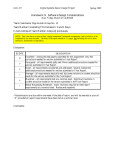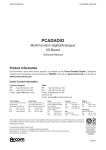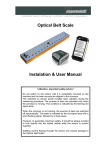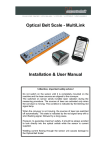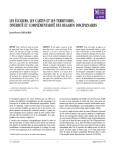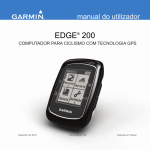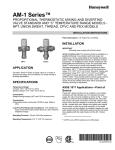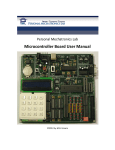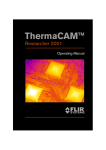Download SH1WH Breakout Board User`s Manual
Transcript
SH-1 Embedded Workhorse Breakout-Board User Manual Version 1.0 January 1999 Xtreme Ideas Technology Development Xtreme Ideas Technology Development NOTICE This document is subject to change without notice. Neither Xtreme Ideas Technology Development nor the inventor, Andrew Huang, will be held responsible for any damage to the user or user’s assets that may result from accidents or any other reasons during operation of the user’s unit according to this document. No license is granted by implication or otherwise under any patents or other rights of any third party or Xtreme Ideas Technology Devolpment, or Andrew Huang. This product is not authorized for use in medical applications, including but not limited to life support systems. © 1998 Andrew Huang, All Rights Reserved The Xtreme Ideas logo is a trademark of Xtreme Ideas Technology Development SH-1 Embedded Workhorse Breakout Board User's Manual 2 Xtreme Ideas Technology Development 1 Feature Summary • • • all signals on SH1WH expansion bus broken out into 0.1" spaced dual-row header pads Vutil regulator (+5V linear regulator) Optional FPGA for 32 lines of enhanced digital I/O SH1WH Expansion Bus User Voltage (6.8-13V) Linear Regulator Headers Grouped by Function 5V FPGA Enhanced Digital I/O Expansion Header Figure 1: Block Diagram of SH1WH Breakout-Board SH-1 Embedded Workhorse Breakout Board User's Manual 3 Xtreme Ideas Technology Development Table of Contents 1 FEATURE SUMMARY 3 DESCRIPTIVE SPECIFICATIONS 5 1.1 5 Power Supply 1.2 Jumper Locations and Pinouts 1.2.1 JP1 – Analog Header 1.2.2 JP2 – Power Management and SH-1 Direct I/O 1.2.3 JP3 – A/D Trigger Header 1.2.4 JP5 – Motor Control Header 1.2.5 JP6 – Processor Expansion Header 1.2.6 JP7 – Vutil Breakout Header 1.2.7 JP8 – Vbatt Breakout Header 1.2.8 JP9 – Enhanced Digital I/O Header 1.2.9 Vbatt Terminal Block 5 5 5 6 6 6 7 7 8 8 1.3 Signal Descriptions 1.3.1 Direct Processor Bus Signals 1.3.2 Digital I/O 1.3.3 Analog Signals 1.3.4 Power Control 1.3.5 Power 1.3.6 Miscellaneous 9 9 10 10 11 11 11 2 LOCATION OF HEADERS 11 3 UCF-FORMAT PIN LOCATIONS FOR FPGA 12 SH-1 Embedded Workhorse Breakout Board User's Manual 4 Xtreme Ideas Technology Development Descriptive Specifications 1.1 Power Supply The SH1WH-BB1 has a screw-type terminal block for connecting power to both the breakout board and other boards in the expansion connector stack. The voltage applied to the terminal block is distributed to other boards in two forms; the raw voltage is applied to other boards as Vbatt, and a regulated +5V voltage is provided as Vutil. The voltage input is restricted to a range of 6.8V to 13V due to the +5V linear regulator on board the breakout board (the SH1WH alone can accept voltages as low as 3.8V by itself). The +5V regulated output is used by the FPGA. Boards without the FPGA option that do not use Vutil can operate at lower voltages without failure. 1.2 Jumper Locations and Pinouts The SH1WH-BB1 has 8 headers and one terminal block total. The headers are provided unpopulated so the user can put either male or female connectors of various lengths and styles, depending on the user's application. 1.2.1 JP1 – Analog Header The analog header breaks out 8 A/D channels as well as 2 D/A channels and their reference voltages. Note that the grounds on this header are the analog grounds, and they should not be tied to the digital grounds for best analog performance. The tie point between analog and digital grounds is internal to the SH1WH board. AGND 1 AN0 3 AN2 5 AN4 7 AN6 9 AGND 11 AGND 13 Aout0 15 2 AVrefI 4 AN1 6 AN3 8 AN5 10 AN7 12 AGND 14 AVrefO 16 Aout1 Figure 2: Analog header pinouts (all views from top) 1.2.2 JP2 – Power Management and SH-1 Direct I/O The power management and SH1-1 Direct I/O header breaks out both Vbatt and Vutil voltages, along with all the power management signals (RESET, NMI, shutdown, and wake up). Also provided on this header are the five A-port processor direct signals; the exact function of these signals is configurable inside the SH-1. Note that these A-port processor direct signals are used to program the FPGA, and thus if the FPGA option is populated, these signals become unavailable for general use. SH-1 Embedded Workhorse Breakout Board User's Manual 5 Xtreme Ideas Technology Development Vutil 1 PA11 3 PA13 5 PA15 7 VBatt 9 RESET 11 shutdwn 13 DGND 15 2 Vutil 4 PA12 6 PA14 8 DGND 10 VBatt 12 NMI 14 wake out 16 DGND Figure 3: Power Mgmt. and SH-1 Direct I/O Header Pinouts 1.2.3 JP3 – A/D Trigger Header The A/D trigger header is provided so users can connect an external A/D trigger source to the SH1WH for precise timing of A/D sampling. Note that this header has DGND (not AGND) as a reference, since the trigger signal is a digital signal. Also note that the A/D trigger feature can not be used at the same time with multiplexed address/data peripherals on the processor expansion header, as the address hold (AH) function is also multiplexed on to this pin inside the SH-1. AH/samp 1 2 DGND Figure 4: A/D Trigger Header Pinouts 1.2.4 JP5 – Motor Control Header All motor control lines are made available on this header for diagnostic purposes. This also allows for a configuration of breakout-board plus motor driver card in case users already have a PWM signal source that they want to connect to the motor driver card. DGND 1 PWM0 3 EN0 5 DIR0 7 DGND 9 PWM2 11 EN2 13 DIR2 15 PWM4 17 EN4 19 2 DGND 4 PWM1 6 EN1 8 DIR1 10 DGND 12 PWM3 14 EN3 16 DIR3 18 DIR4 20 DGND Figure 5: Motor Control Header Pinouts 1.2.5 JP6 – Processor Expansion Header The processor expansion header allows users to connect extra memory-mapped peripherals to the SH-1. SH-1 Embedded Workhorse Breakout Board User's Manual 6 Xtreme Ideas Technology Development Vutil 1 AD0 3 AD2 5 AD3 7 AD6 9 DGND 11 A0 13 A2 15 A4 17 A6 19 DGND 21 CS6 23 RD 25 RESET 27 CLK 29 2 Vutil 4 AD1 6 AD3 8 AD5 10 AD7 12 DGND 14 A1 16 A3 18 A5 20 A7 22 AH/samp 24 CS7 26 WR 28 DGND 30 DGND Figure 6: Processor Expansion Header Pinouts 1.2.6 JP7 – Vutil Breakout Header The Vutil breakout header is provided so users can have a convenient source of regulated +5V for their projects. There are a couple of NC pins so users can put in a keyed connector to prevent users from plugging in a power connector backwards. Vutil 1 Vutil 2 NC 3 PGND 4 NC 5 PGND 6 Figure 7: Vutil breakout header 1.2.7 JP8 – Vbatt Breakout Header The Vbatt breakout header is provided so users can have a convenient source of unregulated power. It also provides an alternative method to connecting up Vbatt if they do not wish to use the terminal block. VBatt 1 VBatt 2 NC 3 PGND 4 NC 5 PGND 6 Figure 8: Vbatt breakout header SH-1 Embedded Workhorse Breakout Board User's Manual 7 Xtreme Ideas Technology Development 1.2.8 JP9 – Enhanced Digital I/O Header The enhanced digital I/O header breaks out 32 signals plus ground from the FPGA. These signals can take on a large number of functions, depending on what configuration the FPGA has. DGND 1 DIG0 3 DIG2 5 DIG4 7 DIG6 9 DGND 11 DIG8 13 DIG10 15 DIG12 17 DIG14 19 DGND 21 DIG16 23 DIG18 25 DIG20 27 DIG22 29 DGND 31 DIG24 33 DIG27 35 DIG28 37 DIG30 39 2 DGND 4 DIG1 6 DIG3 8 DIG5 10 DIG7 12 DGND 14 DIG9 16 DIG11 18 DIG13 20 DIG15 22 DGND 24 DIG17 26 DIG19 28 DIG21 30 DIG23 32 DGND 34 DIG25 36 DIG27 38 DIG29 40 DIG31 Figure 9: Enhanced Digital I/O Header Pinouts 1.2.9 Vbatt Terminal Block The Vbatt terminal block provides convenient screw terminals to which users can connect voltages from 6.8V to 13V to power the card stack. View from side of board + Figure 10: Terminal Block Pinouts SH-1 Embedded Workhorse Breakout Board User's Manual 8 Xtreme Ideas Technology Development 1.3 Signal Descriptions 1.3.1 Direct Processor Bus Signals AD[7:0] I/O Multimode address and data bus. Depending on access location, this bus may behave either as a multiplexed address/data bus or as just a data bus. This bus may also be treated as either a simple 8-bit bus or the lower byte of a 16-bit wide bus. A[7:0] O Address bits from the processor RD O Read enable from the processor, active low WR O Write enable from the processor, active low CS7 O Chip select from the processor, active low. This CS line corresponds to 8-bit accesses with an unmultiplexed bus mode in addresses from 0x7000000 to 0x7FFFFFF. CS6 O Chip select from the processor, active low. This CS line corresponds to 8 or 16-bit wide accesses in a multiplexed address/data bus mode in addresses from 0x6000000 to 0x6FFFFFF; if the 14th address bit is high, then the bus behaves as if it were 16 bits wide; if it is low, then the bus behaves as if it were 8 bits wide. It also corresponds to 16-bit accesses in an unmultiplexed bus mode in addresses from 0xE000000 to 0xEFFFFFF. RES I/O Hard reset, active low. This signal is debounced and pulled low for 250 ms on any of the following conditions: reset button depressed, Vcc out of range (2.88V typ.), power-on reset, or watchdog timer time-out (if enabled). A hard reset will clear processor state and is required to wake up out of deep-sleep modes. RES is a wired-AND signal, so users may pull RES low to force a reset condition. CLK O 12 MHz clock signal, synchronous to direct processor bus signals NMI O Non-maskable interrupt output. This signal is triggered when the alarm clock in the RTC times out, or when the user depresses the NMI button. AH/samp I/O Software configurable pin to either address hold output or A/D sample trigger input. Address hold is used when the expansion bus is in multiplexed address/data mode. A/D sample trigger is optional as the sample trigger can be set by software as well. SH-1 Embedded Workhorse Breakout Board User's Manual 9 Xtreme Ideas Technology Development 1.3.2 Digital I/O PA[15:11] I/O Programmable function digital I/O ports. In addition to simple digital I/O, PA[15:12] can also be remapped in software to function as active-low interrupt lines or DMA handshaking lines; PA11 can be remapped to function as a timing pattern generator output. PWM[4:0] I/O Pulse width modulation control output. Dedicated hardware drive these lines with square waves of varying duty cycles; properties of the PWM output are set by software. These signals can also be configured to function as digital I/O, timing pattern generator outputs, or as interval timer inputs. EN[4:0] O Dedicated digital outputs. While the label may suggest that it can be used to enable motors under PWM control, this output may be used for any function. EN[4:0] maps to bits 4:0 of any data written to locations ranging from 0xA000000 through 0xAFFFFFF. DIR[4:0] O Dedicated digital outputs. While the label may suggest that it can be used to set the direction of motors under PWM control, this output may be used for any function. DIR[4:0] maps to bits 12:8 of any data written to locations ranging from 0xA000000 through 0xAFFFFFF. 1.3.3 Analog Signals AN[7:0] I Input to A/D converter. The A/D converter is a 10-bit SAR type converter. Aout[1:0] O Output of D/A converters. The D/A converters have 12-bit resolution. AVrefI O Reference voltage used by the A/D converter. This AGND-referenced voltage represents the maximum voltage that the A/D converter can sample. Excessive current draw from this output will affect A/D converter accuracy. AVrefO O Reference voltage used by the D/A converter. This AGND-referenced voltage represents the maximum voltage output by the D/A converter. Excessive current draw from this output will affect D/A converter accuracy. AGND PWR Analog ground. This is an isolated, low-current return path for analog signals. SH-1 Embedded Workhorse Breakout Board User's Manual 10 Xtreme Ideas Technology Development 1.3.4 Power Control shutdwn I A high input on this pin causes the switching regulator to shut down, effectively turning the board off. This input is internally tied low with a 10K resistor. wakeout O This is an alarm clock output that functions regardless of the state of Vcc. Its polarity and trigger time is programmable. It is internally connected to the NMI of the processor. 1.3.5 Power Vutil NC This is a utility voltage pin provided on the expansion headers for use by expansion cards. It is not connected on the SH1WH. DGND PWR Digital signal ground. PGND PWR Power ground; high current return path for system power. Vbatt PWR System power. Nominally provided by a battery, but any unregulated DC input between 3.8 and 13V is acceptable. 1.3.6 Miscellaneous NC NC Internally not connected. For use by expansion cards. 2 Location of Headers JP6 JP7 JP5 JP1 JP2 JP8 JP3 JP9 Vbatt Header Figure 11: Location of headers and respective pin 1 locations SH-1 Embedded Workhorse Breakout Board User's Manual 11 Xtreme Ideas Technology Development 3 UCF-Format Pin Locations for FPGA The following listing is a Xilinx User Constraint File (.UCF) compatible mapping of pin numbers to pin functions for the FPGA aboard the SH1WH-BB1-FPGA. This listing assumes the user places all I/O functions into a hierarchical block with the designator "U1". This listing is compatible with the Xilinx Foundation Series tools, version 1.5. An archived sample project with this information in a .UCF file for the Xilinx tools is available on the web at http://www.ai.mit.edu/people/bunnie/sh1wh/fpga.zip. NET U1/PCLK LOC = P2; NET U1/DIG0 LOC = P3; NET U1/DIG1 LOC = P7; NET U1/DIG2 LOC = P8; NET U1/DIG3 LOC = P9; NET U1/DIG4 LOC = P10; NET U1/DIG5 LOC = P13; NET U1/DIG6 LOC = P14; NET U1/DIG7 LOC = P15; NET U1/DIG8 LOC = P16; NET U1/DIG9 LOC = P17; NET U1/DIG10 LOC = P18; NET U1/DIG11 LOC = P19; NET U1/DIG12 LOC = P20; NET U1/HDC LOC = P28; NET U1/DIG13 LOC = P29; NET U1/DIG14 LOC = P31; NET U1/DIG15 LOC = P32; NET U1/DIG16 LOC = P33; NET U1/DIG17 LOC = P34; NET U1/DIG18 LOC = P35; #NET U1/P_PA14 LOC = P36; NET U1/DIG19 LOC = P39; NET U1/DIG20 LOC = P40; NET U1/DIG21 LOC = P41; NET U1/DIG22 LOC = P42; NET U1/DIG23 LOC = P43; NET U1/DIG24 LOC = P44; NET U1/DIG25 LOC = P45; NET U1/DIG26 LOC = P46; NET U1/DIG27 LOC = P47; #NET U1/P_PA15 LOC = P50; #NET U1/P_PA13 LOC = P52; NET U1/P_PA13C1 LOC = P58; NET U1/P_PA13C2 LOC = P54; NET U1/DIG28 LOC = P53; NET U1/DIG29 LOC = P55; NET U1/DIG30 LOC = P56; NET U1/DIG31 LOC = P57; NET U1/P_TIOCA4 LOC = P59; NET U1/P_AD0 LOC = P60; NET U1/P_AD1 LOC = P61; NET U1/P_AD2 LOC = P62; NET U1/P_AD3 LOC = P65; NET U1/P_AD4 LOC = P66; SH-1 Embedded Workhorse Breakout Board User's Manual 12 Xtreme Ideas Technology Development NET U1/P_AD5 LOC = P67; NET U1/P_AD6 LOC = P68; NET U1/P_AD7 LOC = P69; NET U1/P_A0 LOC = P70; NET U1/P_A1 LOC = P71; #NET U1/P_PA12 LOC = P72; #NET U1/P_PA11 LOC = P74; NET U1/P_A2 LOC = P78; NET U1/P_A3 LOC = P80; NET U1/P_A4 LOC = P81; NET U1/P_A5 LOC = P82; NET U1/P_A6 LOC = P83; NET U1/P_A7 LOC = P84; NET U1/P_AH_N LOC = P85; NET U1/P_CS6_N LOC = P86; NET U1/P_CS7_N LOC = P87; NET U1/P_RD_N LOC = P90; NET U1/P_WR_N LOC = P91; NET U1/RESET LOC = P92; NET U1/SHUTDOWN LOC = P93; NET U1/NMI LOC = P94; NET U1/WD_TRIG LOC = P95; NET U1/P_TIOCA0 LOC = P96; NET U1/P_TIOCA1 LOC = P97; NET U1/P_TIOCA2 LOC = P98; NET U1/P_TIOCA3 LOC = P99; SH-1 Embedded Workhorse Breakout Board User's Manual 13 Xtreme Ideas Technology Development NOTES: SH-1 Embedded Workhorse Breakout Board User's Manual 14















